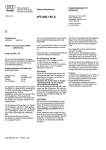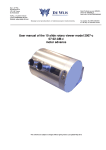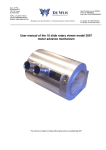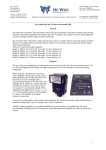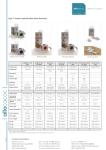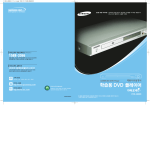Download User manual Viewer illumination 05-13C-LA For the
Transcript
de Wijs. Vleugelboot 68, 3991 CL Houten the Netherlands Tel. +31 (0)30 - 6364928 Fax. +31 (0)30 - 6361723 e-mail: [email protected] Website: www.dewijs-3d.com Design and production of stereoscopic instruments. Account number: 129079073 Swiftcode/BIC: RABONL2U IBAN: NL78RABO0129079073 Bank: Rabobank Houten Street: Hofspoor 1 Postal code: 3994VZ City: Houten Tax number: NL 1899.16.084 B01 K.v.K. Reg. Nº 23071201 Utrecht User manual Viewer illumination 05-13C-LA modification 2012 For the Combi 3D slide viewer The content of this document is subject of change without notice. November 2012 General: This viewer illumination is designed to couple with the Combi 3D viewer models of 1994, 2000 and 2003. Model 1997 is to narrow. In 2012 the light source and the electronics have been modified. The light source is now based on LED back light and operates on a lead acid gel battery as well as a mains adapter. The 5000 Kelvin color white illumination will present your images with the original colors even when the lamp is dimmed. Mount the viewer illumination on the Combi viewer. • • • • • • Put the illumination upside down on the table. At the front – underside you see a small metal strip as shown in the right image. It can be pushed away inside the housing. Take a pen and push with the tip the metal strip aside at the underside in the hole. Now take the viewer and let it shift in the grooves at both sides of the illumination housing If you mount it for the first time, you have to adjust the steel clamps at the left and right side to fit properly with your model of Combi viewer. When the viewer fits, release the metal strip as soon as the viewer is totally dropped in its slot. Normal use of the viewer illumination. Pushing the red button turns on the light. Releasing it turns it off. When the viewer illumination is connected to the external adapter, the battery is charged anytime. With the connected adapter and the black slide switch is moved, the lamp turns on and stays on. This only applies when the external adapter is used. Brightness can be adjusted by turning the knob at the rear. Battery In mobile use, the viewer illumination runs on a single lead acid battery of 6 Volts 1.3Ah. During tests it appeared that the illumination runs for about 6 hours. The LED back light uses about 160 mA. at 5 Volts dc. As soon as the external adapter is connected, the battery is charged until a certain voltage level is reached, then it stops. A small red LED at the power plug indicates charging. This is a low charging current so from empty to full takes about 1 day. Exchanging the battery: After a significant time it appears that the battery does not have enough power for good operation even when charged. It has to be replaced. - - At the underside, remove the four M3 bolts and remove the cover Now carefully remove the 2 small white connectors at the rear of the housing (with red and black leads). Pull them straight out of the socket, don’t tilt them, it might break the socket. Take the battery unit at the sides and pull it out of the housing. The LED panel comes free as well. Now unplug the connector on the battery and replace it on the new battery. Warning! Pay attention to the polarity of the battery; red lead to +, black to Warning! Take notice of the position of the small white connectors at the rear when you replace them; replace the battery plug to the correct socket. Adding color filters to the back light The 5000K color temperature of the LED backlight (pure white) is considered as base to change to light color temperatures of your choice. To reduce the color temperature to about 4600K, which is a warmer tint, can be achieved by for example Lee filter type 443. This filter is already inserted between the front colorless plexi-glass plate and the LED panel. To replace the filter, you need to take the battery out first. See the previous chapter for directions how to do this. Then the LED panel and the plexi-glass plate are coming out as well. Be careful with the leads to the LED panel, they are vulnerable. Do not bend the contact points of the LED panel, they break otherwise. Technical information. Type of illumination External and internal Voltage Power consumption. Charge current of the batteries Illuminated area Width of the coupled viewer Expected lifespan of the lamp. With full batteries expected usage time. Electronic schematics. LED back light 5000K 130x60 mm. 5Vdc 160 mA. 12 Vac 500mA. external and 9 Vdc stabilized internal. 160 mA for the lamp, in total 3.5 Watts (with charging) plug 5,5 mm. outer 2,1 mm. inner. < 125mA 109 x 47.5 mm. 120 mm. x 55 mm. Height 30.000 hours, given by the lamp factory. ± 6 hours, depending on the type of battery and condition. Electronic design explanation. Power: 12 Volts ac should be connected to the light attachment. The circuit holds a rectifier and voltage stabilizer to 9 Volts dc. Battery: The 6 Volts lead acid battery 1.3 Ah. Is able to provide about 6 hours of light when full charged. The choice for this battery is because it does not need a difficult charging circuit, the battery is one unit with solid connections, easy to replace. Charging: The charging curve of the lead acid battery is a little slope climbing up to about 7.45 Volts. In the circuit a operational amplifier is checking the battery voltage and a pre-set cut-off voltage (P2). Around this pre-set voltage, a hysteresis of about 0,5 Volts is added. So this pre-set voltage is set to 7 Volts. The charging starts at 6.75 Volts and stops at 7.25 Volts. You can check the pre-set voltage at TP1. The hysteresis compensated battery voltage can be checked on TP2. Both with respect to ground. The charging current is limited by LM317 and R9 to about 125mA. Even when the battery is short circuited / defect. Power for the LED backlight: The relais in the circuit play’s an active role for the change of battery powered or adapter powered use. It prohibits the battery to be discharged by the charging circuit when not in use and prohibits the battery to be discharged when the slide switch is set to continuous light in mobile use and not turned off. The feature of dimming the light is realized around opamp U3. A zener diode D7 provides a stable 5.1 volts reference for the driver circuit of the LED panel.






